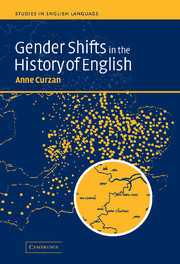Book contents
- Frontmatter
- Contents
- Acknowledgments
- Introduction
- 1 Defining English gender
- 2 The gender shift in histories of English
- 3 A history of gender, people, and pronouns: the story of generic he
- 4 Third-person pronouns in the gender shift: why is that ship a she?
- 5 Gender and asymmetrical word histories: when boys could be girls
- 6 Implications for nonsexist language reform
- Appendix 1 Background on early English personal pronouns
- Appendix 2 Helsinki Corpus texts and methodology
- References
- Index
2 - The gender shift in histories of English
Published online by Cambridge University Press: 22 September 2009
- Frontmatter
- Contents
- Acknowledgments
- Introduction
- 1 Defining English gender
- 2 The gender shift in histories of English
- 3 A history of gender, people, and pronouns: the story of generic he
- 4 Third-person pronouns in the gender shift: why is that ship a she?
- 5 Gender and asymmetrical word histories: when boys could be girls
- 6 Implications for nonsexist language reform
- Appendix 1 Background on early English personal pronouns
- Appendix 2 Helsinki Corpus texts and methodology
- References
- Index
Summary
Introduction
In 1936, A. C. Ross succinctly stated, “The loss of grammatical gender in later English is one of the most difficult problems of English philology” (Ross 1936: 321). There is no doubt about the endpoint: in the past millennium, English has shifted from a morphological gender assignment system to a semantic one, so that when Modern English speakers think of “gender” in their language, they think of the pronouns and nouns that refer to gendered entities. But the exact nature of the shift – of what stages it involves – is complex and has never been described or understood in full detail. The next two chapters provide technical details to begin to fill some of the gaps in knowledge of the historical shift from grammatical to natural gender in English, sometimes referred to as “the gender shift” in the history of English. This chapter focuses on the ways in which the gender shift has been framed before – a historiography of histories of English focused on their telling of the story of the gender shift – and what this can tell us about attitudes toward language and gender, as well as language change more generally.
In the history of the English language, the shift from Old English to Middle English is often cited as one of the most important defining periods in the evolution of the modern language. It is also one of the most difficult to study.
- Type
- Chapter
- Information
- Gender Shifts in the History of English , pp. 31 - 57Publisher: Cambridge University PressPrint publication year: 2003



